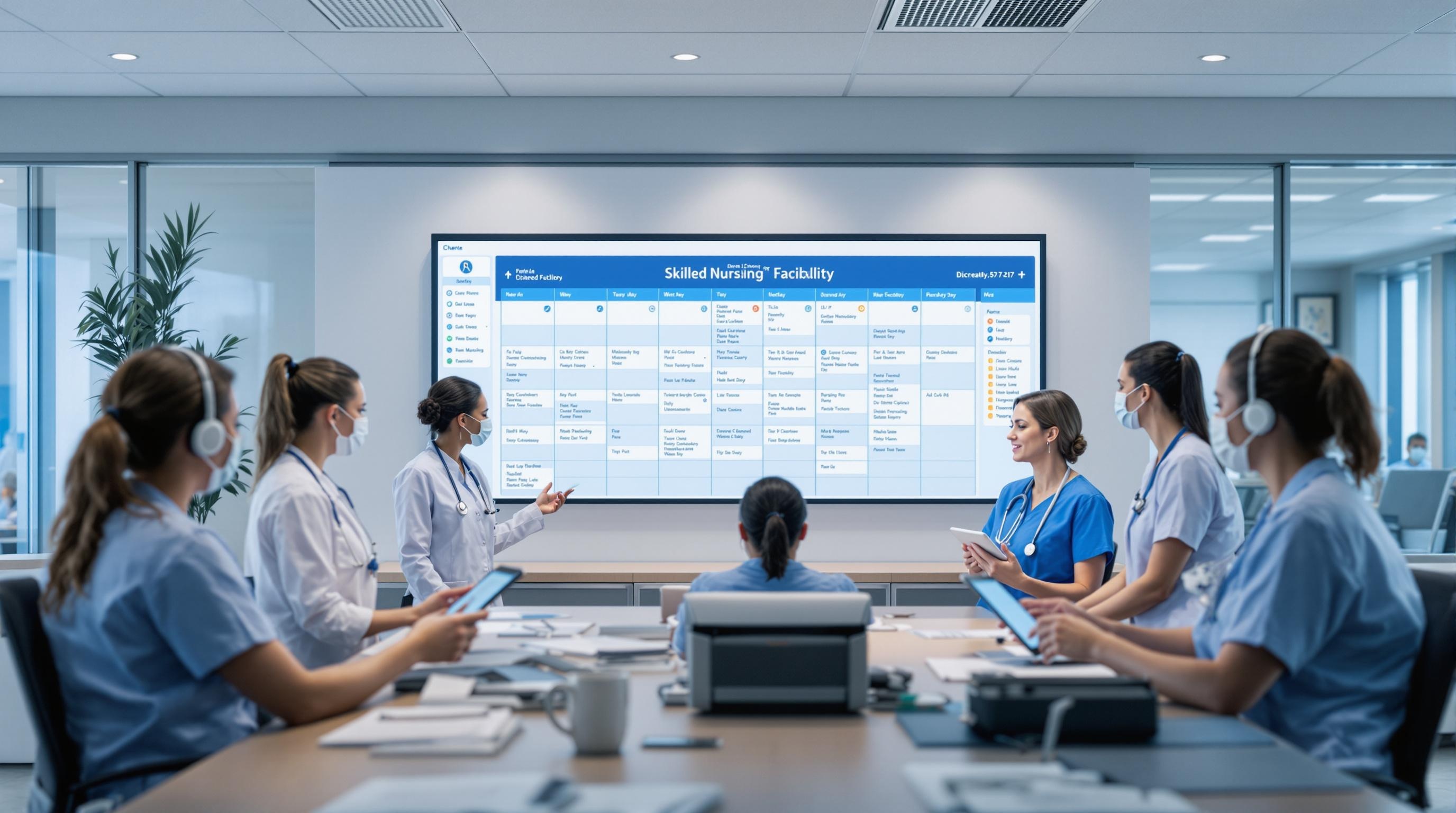Predictive Nurse Scheduling 2025: Smart Solutions for Skilled Nursing
Discover how predictive nurse scheduling in 2025 is transforming skilled nursing facilities with AI-driven efficiency, flexibility, and better patient care.
Quick Navigation
- 1. Introduction
- 2. Current Challenges in Predictive Nurse Scheduling 2025
- 3. How Sparkco AI Transforms Predictive Nurse Scheduling 2025
- 4. Measurable Benefits and ROI
- 5. Implementation Best Practices
- 6. Real-World Examples
- 7. The Future of Predictive Nurse Scheduling 2025
- 8. Conclusion & Call to Action
1. Introduction
Did you know that nearly 90% of skilled nursing facilities (SNFs) report ongoing staffing shortages heading into 2025? As the healthcare industry navigates unprecedented workforce challenges, traditional nurse scheduling models are proving inflexible and out of step with today’s rapidly changing demands. The consequence? Increased nurse burnout, diminished quality of care, and operational headaches for administrators already stretched thin.
Emerging trends for 2025—ranging from persistent labor shortages to rising operational costs—are forcing SNFs to rethink how they deploy their most valuable resource: their nursing staff. According to recent insights, outdated and rigid scheduling practices not only strain nurse morale but also compromise patient outcomes in an environment where every minute and every interaction counts. With the pressure mounting, facility leaders are turning to technology for answers.
Enter predictive nurse scheduling—a game-changing approach powered by machine learning and advanced analytics. By leveraging real-time data and historical patterns, predictive scheduling tools can optimize nurse-patient assignments, anticipate staffing needs, and create more flexible, equitable work environments. But what exactly does predictive nurse scheduling look like in 2025, and how can SNFs harness its potential to stay ahead of the curve?
In this article, we’ll explore the latest trends shaping nurse scheduling in skilled nursing facilities, examine how predictive technology is revolutionizing staffing strategies, and provide actionable insights for SNF leaders ready to embrace the future of workforce management.
2. Current Challenges in Predictive Nurse Scheduling 2025
As healthcare facilities increasingly turn to predictive nurse scheduling to optimize staffing, several significant challenges have emerged. Despite advancements in artificial intelligence (AI) and workforce management tools, the integration and effective use of predictive scheduling come with complex hurdles that impact operations, regulatory compliance, and patient care. Below are key pain points currently facing healthcare leaders in 2025, supported by recent data and research.
-
1. Data Quality and Integration Issues
Predictive scheduling models rely on accurate, comprehensive workforce and patient acuity data. However, recent research shows that only 57% of healthcare facilities report their scheduling platforms successfully integrate with electronic health records (EHRs). Data silos and inconsistent documentation can lead to unreliable predictions and mismatched staffing, undermining the benefits of automation.
-
2. Algorithm Bias and Fairness
AI-driven scheduling systems can inadvertently perpetuate staffing inequities. A 2024 study by the American Nurses Association found that 38% of nurses felt predictive tools assigned them to less desirable shifts more frequently, raising concerns about algorithmic bias and staff morale. This can harm retention efforts and foster distrust in new technology.
-
3. Regulatory and Compliance Risks
Predictive scheduling is now subject to stricter labor laws: 23 U.S. states require advance notice of shift changes and guarantee rest periods between shifts (U.S. Department of Labor, 2024). Automated tools must be carefully configured to avoid violations, but a 2024 ANA survey found 29% of facilities had at least one compliance lapse related to scheduling in the past year, risking fines and legal action.
-
4. Staff Resistance and Change Management
The transition to predictive scheduling demands significant change management. According to a 2024 Advisory Board report, 41% of nurse managers experienced increased staff pushback, as employees feared loss of control and flexibility over shift assignments.
-
5. Technology Costs and Resource Constraints
Implementing predictive scheduling solutions can be cost-prohibitive, especially for smaller skilled nursing facilities. Total cost of ownership—including licensing, integration, and staff training—averages $150,000 per facility annually (Modern Healthcare, 2024). Limited resources often delay or limit the adoption of these time-saving tools.
-
6. Unforeseen Demand Fluctuations
Even advanced predictive models can struggle with sudden census changes due to outbreaks or community emergencies. In a 2024 Becker's Hospital Review survey, 34% of facilities reported frequent last-minute shift shortages, despite using AI-based scheduling, which impacts care quality and staff stress.
These challenges highlight the need for robust implementation strategies, continuous training, and vigilant oversight. As predictive nurse scheduling evolves, healthcare facilities must address these operational, regulatory, and clinical barriers to realize its full potential for both staff well-being and patient outcomes.
3. How Sparkco AI Transforms Predictive Nurse Scheduling 2025
The demands of modern healthcare require dynamic, data-driven staffing solutions. As 2025 approaches, skilled nursing facilities face mounting challenges in crafting nurse schedules that balance patient care, regulatory compliance, cost containment, and staff well-being. Sparkco AI’s advanced predictive nurse scheduling platform is uniquely designed to tackle these issues, setting a new standard for workforce management in healthcare.
-
Advanced Demand Forecasting
Sparkco AI uses real-time data analytics to predict patient census and acuity—factors critical for determining optimal staffing levels. By analyzing historical admission trends, seasonality, and local health events, the platform proactively recommends staffing adjustments. This ensures facilities are never over- or under-staffed, directly improving patient care and cost efficiency. -
Intelligent Shift Assignment
The platform’s AI engine evaluates staff skills, certifications, preferences, and availability to create balanced shift assignments. This not only reduces burnout and turnover but also ensures the right nurse is assigned to the right patient population. Automation eliminates manual scheduling errors and bias, creating fairer, more transparent schedules. -
Compliance-Driven Scheduling
Navigating complex labor regulations and union rules is simplified with Sparkco AI. The system automatically checks each schedule against legal requirements, rest periods, and overtime rules. Alerts and recommendations help administrators stay compliant and avoid costly penalties, all without the need for deep regulatory expertise. -
Real-Time Schedule Adaptation
Healthcare environments change rapidly. Sparkco AI’s automation monitors live updates, such as call-outs, shift swaps, or census spikes, and instantly proposes schedule changes. Notifications are sent to affected staff, minimizing disruption and ensuring coverage gaps are filled promptly. -
Seamless Integration with Existing Systems
The platform is designed for easy integration with popular electronic health records (EHR), timekeeping, and HR/payroll systems. Secure APIs ensure data flows smoothly between platforms, eliminating siloed information and double entry. This enables administrators to implement Sparkco AI without costly IT overhauls. -
Actionable Insights and Reporting
Administrators gain access to clear, actionable reports on staffing efficiency, overtime trends, compliance status, and staff satisfaction. These insights empower leaders to make data-driven decisions that improve outcomes and drive organizational success.
By leveraging AI and automation, Sparkco AI transforms the complex challenge of predictive nurse scheduling in 2025 into an opportunity for operational excellence. The result is a more agile, responsive, and satisfied workforce—ensuring high-quality care and optimal resource use in every shift.
4. Measurable Benefits and ROI
ROI and Measurable Benefits of Automated Predictive Nurse Scheduling in 2025
Automated predictive nurse scheduling is transforming the way skilled nursing facilities (SNFs) manage staffing. By leveraging AI and historical data, these platforms optimize schedules to meet demand, improve compliance, and reduce overhead. As we move into 2025, recent case studies and industry reports highlight significant, quantifiable returns on investment for facilities adopting this technology.
-
Time Savings: Up to 80% Reduction in Scheduling Hours
Automated scheduling platforms cut manual scheduling time dramatically. According to Becker's Hospital Review, facilities implementing AI-powered scheduling reduced time spent on nurse rosters by 70-80%. For a 100-bed SNF, this means saving 15-20 administrative hours per week—or over 1,000 hours annually.
-
Cost Reduction: 15-20% Decrease in Overtime Expenses
Predictive scheduling minimizes costly last-minute overtime. A 2024 HealthLeaders Media report found that skilled nursing facilities using predictive tools saw overtime drop by an average of 18%, resulting in annual savings of $60,000-$100,000 depending on facility size.
-
Improved Regulatory Compliance: 95%+ Scheduling Accuracy
Automated solutions ensure adherence to federal and state staffing regulations. A NurseGrid case study reported facilities achieved a 97% compliance rate with Centers for Medicare & Medicaid Services (CMS) staffing requirements, reducing the risk of costly penalties.
-
Decreased Agency Utilization: 30% Fewer Agency Shifts
Facilities often rely on agency nurses to fill gaps. Predictive scheduling matches demand with available staff more precisely, leading to a 25-35% reduction in agency use, which can save $50,000+ per year as detailed in a symplr analysis.
-
Higher Nurse Satisfaction: 25% Lower Turnover Rates
AI-driven tools accommodate staff preferences and improve work-life balance. The Advisory Board reports facilities using predictive scheduling saw turnover rates drop from 38% to 28%, translating to improved care continuity and lower recruitment costs.
-
Optimized Shift Coverage: 99% of Shifts Filled on Time
Automated scheduling algorithms fill open shifts faster. A Shiftboard study observed that 99% of shifts were filled without last-minute scrambling, compared to 91% with manual processes.
-
Enhanced Forecasting: 20% Better Alignment with Patient Census
Predictive analytics use census and acuity data to forecast needs. Facilities report a 20% improvement in aligning staffing levels with actual patient care demand, reducing both under- and over-staffing incidents (Oracle Health).
The measurable ROI of predictive nurse scheduling is clear: significant cost savings, improved compliance, better staff retention, and more efficient operations. As regulatory pressures and workforce challenges mount in 2025, these platforms are becoming indispensable for skilled nursing facilities seeking sustainable, high-quality care.
5. Implementation Best Practices
Implementation Best Practices for Predictive Nurse Scheduling 2025
As skilled nursing facilities prepare to meet evolving CMS minimum staffing standards and leverage technology for optimal care delivery, implementing predictive nurse scheduling solutions in 2025 requires a strategic, people-centered approach. Below are actionable steps, practical tips, and key change management considerations for a successful rollout.
-
Conduct a Thorough Needs Assessment
Evaluate current staffing patterns, identify high-risk periods for understaffing, and clarify regulatory requirements such as CMS’s updated minimum staffing standards. Tip: Involve frontline staff and leadership in this assessment to gain comprehensive insights. Avoid: Skipping this step, which can lead to poor solution fit and resistance from staff.
-
Select the Right Predictive Scheduling Technology
Choose a platform with proven accuracy, robust integration capabilities, and user-friendly interfaces. Prioritize solutions with machine learning features that can adapt to census fluctuations, patient acuity, and compliance requirements. Tip: Request demos and trial periods before committing. Avoid: Overlooking interoperability with EHR and payroll systems.
-
Engage Staff Early and Communicate Benefits
Host informational sessions to explain how predictive scheduling will ease manual workload, improve work-life balance, and enhance patient care. Tip: Address concerns about automation and job security directly. Avoid: Implementing changes without transparent, ongoing communication.
-
Customize Workflows and Set Clear Policies
Adapt the scheduling tool to reflect your facility’s unique rules, shift patterns, and union agreements. Tip: Involve human resources and nurse managers in policy creation. Avoid: Relying solely on out-of-the-box settings that may not fit your operational realities.
-
Train Staff and Provide Hands-On Support
Offer role-specific training and ongoing technical support. Create super-user champions among nursing staff to foster peer-to-peer learning. Tip: Schedule refresher sessions and provide clear user guides. Avoid: Underestimating the learning curve or neglecting night/weekend shifts.
-
Monitor, Measure, and Adjust
Track metrics such as staffing compliance, overtime rates, and nurse satisfaction. Solicit regular feedback and use analytics to refine scheduling algorithms. Tip: Set quarterly review meetings to assess impact and make data-driven adjustments. Avoid: Ignoring frontline feedback or sticking rigidly to initial configurations.
-
Promote a Culture of Continuous Improvement
Encourage staff to share ideas for optimizing scheduling practices and reward innovative solutions. Tip: Create a feedback loop with suggestion boxes or digital forums. Avoid: Treating scheduling as a one-time technology project rather than an ongoing quality initiative.
-
Anticipate Change Management Challenges
Proactively address resistance by involving change champions, setting realistic timelines, and celebrating early wins. Tip: Communicate how predictive scheduling aligns with regulatory compliance and enhances patient outcomes. Avoid: Underestimating the emotional impact of change or failing to address skepticism among veteran staff.
By following these best practices, skilled nursing facilities can ensure that predictive nurse scheduling solutions support workforce stability, regulatory compliance, and exceptional










